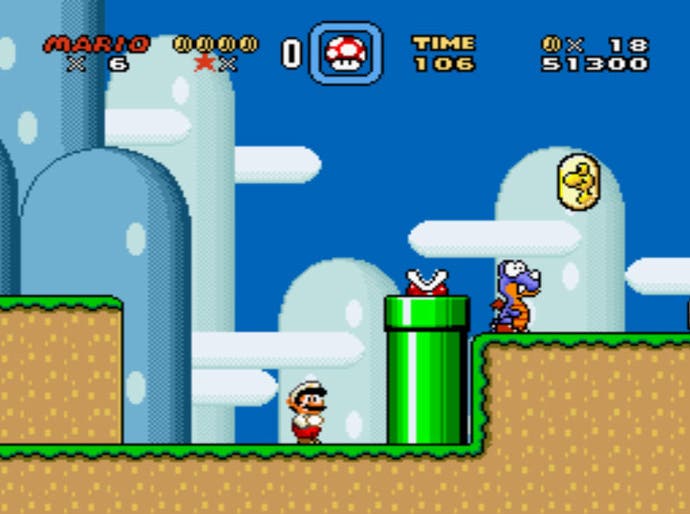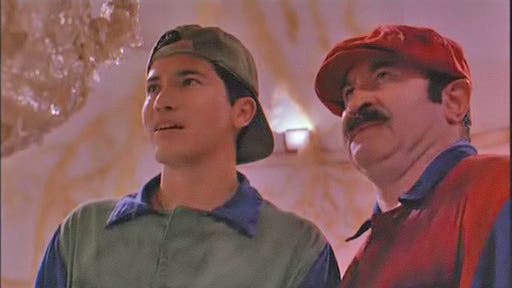The History of Mario
Twenty-five years of plumbing the heights.
Thankfully, all this silly bother was put aside once Super Mario Bros 3 arrived in 1988. In fact, if you ever need a perfect example of how a classic videogame can evolve in just three steps, the Super Mario Bros trilogy is the only one you need to study. Taking the lessons learned from the previous games, Miyamoto and his team served up a third entry that still represents a staggering achievement in 8bit design. A non-linear platform epic, with stages chosen from a top-down map, it boasted cleverly constructed leaping challenges, relentless races against forced scrolling, and standalone boss battles. There were secrets galore, minigames and dozens of cool features to uncover over the course of eight worlds. I'm aware that I often bang on about the wonders of truly classic game design when writing about retro games, and Super Mario Bros 3 is a prime example of my obsession. Every new centimetre of screen that scrolls towards you is purposefully designed to complement what came before, or to introduce what comes next. There's not a pixel of waste in the whole thing, which is why it still holds up today as a genuine great. It is, you will be unsurprised to learn, the final entry in the best-selling videogame trilogy of all time.
1989, of course, also ushered the Game Boy onto the world stage and Mario inevitably graced the system with an all new and exclusive adventure - Super Mario Land. Produced as a solo project by the handheld's creator, and Miyamoto's co-designer way back on Donkey Kong, Gunpei Yokoi. For those who are interested in how a different design aesthetic can subtly change an established formula, Super Mario Land makes for a fascinating experience. It shares much in common with Miyamoto's games, but is also clearly the work of the man behind Metroid in terms of visuals and design. The story is unusual - boasting Tatanga the mysterious spaceman as its villain, and Princess Daisy as the damsel in distress. Clearly Mario's bit on the side, Daisy was swiftly brushed under the carpet in favour of series stalwart Princess Peach, although she did eventually resurface in the N64 Mario sports games. The dirty moo.

Of course, it's worth pointing out that us poor saps in Europe didn't get to join in much of this fun at the time, since we had to wait until 1987 to sample the first Super Mario Bros. Its US sequel wouldn't reach us until 1989, we didn't deserve Super Mario Land until 1990 and the sublime Super Mario Bros 3 didn't taste European air until 1991. A Nintendo spokesman at the time claimed the delay was "because you all smell funny". Probably.
Notable Oddity: All Night Nippon Super Mario Bros, a highly collectable promotional cartridge given out in a raffle by a Japanese radio station. The 1986 release combined levels from various Super Mario versions, and replaced some of the graphics with popular Japanese pop stars and DJs. 1988 also saw the release of the original Mario Bros for the Atari 7800, marking his final appearance on a non-Nintendo console.
1990 to 1996 - The SNES years
By the time Nintendo got around to launching its 16bit console, Sega was already pulling ahead with its cool, none-more-black Genesis/Megadrive machine. With Mario established as the official face of Nintendo gaming, it didn't come as much of a surprise that the Super Famicom/SNES hit the shelves with Mario all over it like a rash. Super Mario World was the game, hurriedly developed to launch with the console alongside Pilot Wings and F-Zero, and it took the Super Mario Bros 3 template and infused it with the sort of complexity and colour that the wheezing NES simply couldn't manage. Indeed, the game was even known as Super Mario Bros 4 in Japan for a while.

As well as beautifully detailed graphics - "It's like playing a cartoon!" we cried, and not for the last time - the game expanded on the gameplay possibilities of the overworld map in ways that still suck you in. Across seven worlds there are 72 levels, linked by 92 exits and entrances. Some are obvious, many are secret with the hidden Star Road and Special Zone opening up the opportunity to find new paths through the game without following a linear order. Working out the quickest or most complete route through the game became an obsession for many, and the game is still a regular challenge in the speed run community. Super Mario World also introduced the latest addition to the expanding Mario cast, the lick-happy Yoshi (then still a species, not a single character), who appeared in multiple forms, flying, spitting fire and stomp-killing koopas. Mario himself was upgraded with a spin-jump attack, cleverly foreshadowing his yet-to-be born rival Sonic. Super Mario World was later packaged into the Mario All-Stars bundle, offering SNESed up ports of the classic NES games.
Having pretty much defined the platform genre, Mario's next major outing would prove that his dungaree-clad arse was good for more than just squashing koopa shells. Powered by the oh-so-exciting Mode 7 graphics technology, Super Mario Kart roared onto Japanese consoles in 1992 (it reached us a mere five months later, for a change) and instantly redefined the boundaries of what could be done within a games franchise. Discovering that the world's best platform game had just spawned one of the world's best racing games was not unlike finding out that Robert DeNiro wrote all The Beatles songs. It's both impressive and more than a little greedy. How much excellence can one series lay claim to?

As well as a smattering of Yoshi games, handheld gamers got their Mario fix in the shape of Super Mario Land 2: 6 Golden Coins, a Game Boy sequel once again overseen by Yokoi rather than Miyamoto. It adopted the map screen from Super Mario World, and also introduced that inverted mini-game loving menace, Wario. Bwah-ha-ha. Etc.
Presumably having exhausted himself, Mario then retreated to the background for a few years while co-stars Yoshi and Wario tested the water with their own range of spin-offs. Indeed, so lazy did the rotund plumber become that he only appeared in Super Mario World 2: Yoshi's Island as a helpless baby, leaving all the real work to his dinosaur chum. I bet he still demanded a £50 call-out charge though. This period also found Mario appearing in more and more educational titles, a trend that had begun with the seemingly random Mario Teaches Typing DOS game in 1991. US SNES owners got to enjoy a trio of pre-school Mario games in 1993, while a slew of puzzle games, such as Mario's Picross, and other oddities, such as the lightgun shooter Yoshi's Safari and headache-inducing Virtual Boy titles, featured his hairy face.

It's also entirely plausible that Mario kept quiet during the mid-90s to avoid the critical fall-out from the mind-bogglingly horrendous 1993 Hollywood movie that bore his name. With Bob Hoskins as Mario, and gurning irritant John Leguizamo as Luigi, it bore little resemblance to the colourful cartoon world of the games, preferring to reinvent the Mario universe as a grungy dystopian alternate dimension, where Dennis Hopper's King Koopa pranced about like a really bad Johnny Rotten impersonator. Not since John Naughton's controversial (and hastily retitled) Kirby: Portrait of a Serial Killer had a Nintendo character been so misrepresented on-screen.
